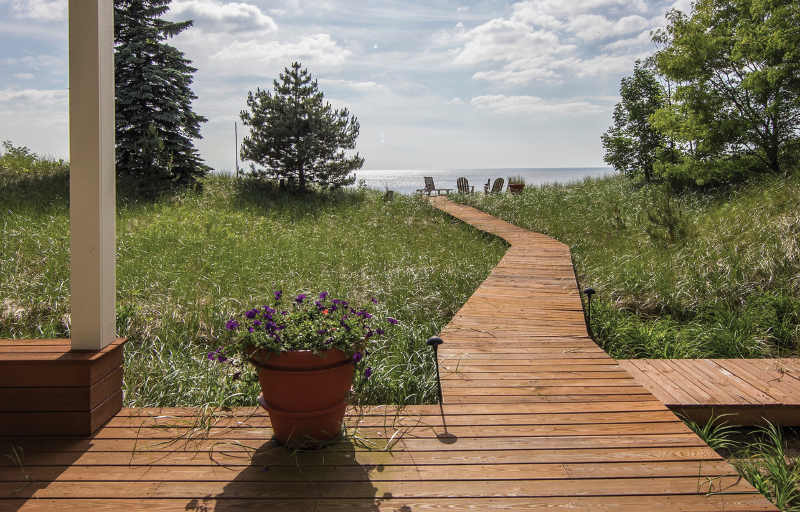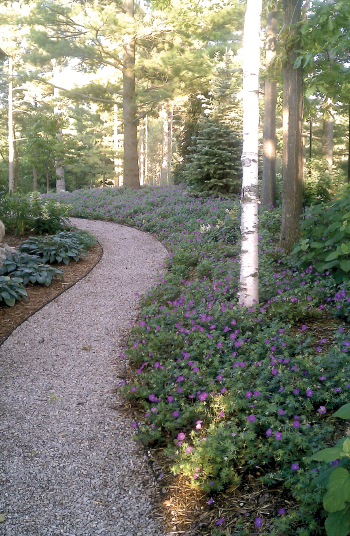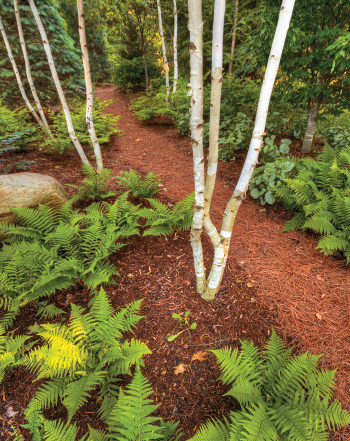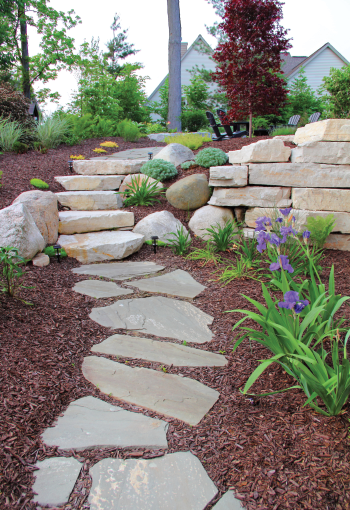
Whether your taste tends to the natural and rustic, more formal or somewhere in between, there are many ways to transform the pathway that gets you to the lake, pond or stream you love into one that provides you with your own blessed release from care and worry. And that’s true even when the route’s a hilly one.

“There are some very, very steep slopes going down to these lakes,” notes Maureen Parker, landscape architect at Common Ground Landscaping in Boyne City, of many of Michigan’s inland and Great Lakes. “If you have a steep slope, you need a way to get from point A to point B.”
Parker’s words sound very utilitarian, but her work and that of other regional waterfront landscape firms in the Great Lakes State show that paths can be so much more than functional. That’s because Parker and her colleagues draw from myriad different “paving” materials, plants and other embellishments, paying close attention to the ways they work together and with the land to both please the eye as well as soothe the soul.
Stops Along The Way
For her Hillside project on Walloon Lake in Petoskey Parker designed a one-of-a-kind outdoor spa: Its infinity edge creates the illusion of being one with a surrounding pond and gurgling stream. The spa, made of gunite, features a Michigan fieldstone boulder interior, custom boulder and black-pebbled lounge seats (each with multiple jets) and fiber optic lighting. Knock Out roses, ligularia, daylilies, hydrangea, reed grass and Japanese silver grass add strong visual punch to the setting.
At the same location, Parker reduced the psychological — and very real — risk of golf cart travel down a 28-degree sloping, tumbled-concrete paver path by angling it 15 degrees inward toward a Mesabi Minnesota granite retaining wall, paired with a concrete curb. While pavers are glued to a concrete base to prevent slippage, trench drains carry away rainwater.
“I remember a hundred lovely lakes, and recall the fragrant breath of pine and fir and cedar and poplar trees. The trail has strung upon it, as upon a thread of silk, opalescent dawns and saffron sunsets. It has given me blessed release from care and worry and the troubled thinking of our modern day. It has been a return to the primitive and the peaceful.”
— American novelist Hamlin Garland, 1899

Parker used a less technically intensive approach for a Burt Lake client who wanted to save a screened-in gazebo with a less-than-spectacular view: She simply moved it. The gazebo now perches on a bluff and offers a stunning view of blue.
Sometimes it takes a unique solution to meet a client’s wishes for a steep site, such as one in Freesoil that overlooks the Sauble River.
“The customer is an avid golfer and they had quite a slope in their backyard,” explains Karen Larsen, owner of Larsen’s Landscaping in Scottville. “So we came up with a design of different terraces.”
One terrace, 17 feet by 18 feet, includes a fire pit recessed into the concrete surface, which the homeowner stained a light terra cotta. (Larsen notes that it’s possible to tint concrete before pouring it.) The other, measuring 20 feet by 30 feet, comprises a putting green of synthetic turf; its undulating surface gives duffers a little extra challenge.
The 2008 project also required retaining walls to create the terraces — a big job that was made even bigger thanks to rain that was deluging the Freesoil region while Larsen’s crew was at work. As a result, “We say our retaining wall can survive a 100-year flood,” she notes good-naturedly.

Near a cottage in Fountain on private Batcheller Lake, fellow Larsen’s designer Megan Schuiteman created an intimate fire pit for two. The curved path leading to the spot — so much more pleasing to the eye than a stick-straight walkway, she says — is Chilton natural flagstone. Prized for its natural lilacs, browns and grays, it was chosen to complement the client’s cottage, enhanced by Michigan field stone veneer. The fire pit itself is built with a Belgard block product to match.
Schuiteman shares that her clients enjoy a great view of the water from this inviting lakeside getaway.
It’s All Material
Many other waterfront home and cottage owners favor Mother Nature’s materials for pathways, as well, from stone and wood to bark and other elements. But a property owner’s preference isn’t necessarily the deciding factor; professional pathway crafters also consider each site’s peculiarities along with rules and regulations regarding storm water runoff, erosion and wetlands protection into their plans and choice of materials.

Landscape designer Krista Rensland of Blue Flower Designs in Grand Rapids, for example, chose an au naturel series of pathways at a client’s home in Omena Point. She used up to three inches of ground hardwood tree bark, or “bark fines,” and layered pine needle mulch — special ordered from a Southern supplier, where it’s more commonly used — on top. This product is easily maintained, eliminates the problem of mud when it rains but yet can support a wheelbarrow.
“It looks woodsy,” Rensland says. “This homeowner really wanted it to look natural.”
“Now we’re kind of seeing a trend for plank-style pavers like ones from Unilock or Belgard. They’re a more modern, linear style.”
— Steve Essex

The medium-brown pine mulch also lends an appealing, subtle contrast to the almost 200 yards of dark brown topsoil-compost mix from Spurt Industries in Zeeland that makes up this waterside property’s woodland beds. Rensland notes that the organics in the mix made the ferns and other plants she added live up to the Spurt name.
“It was unbelievable how everything took off really fast,” she says of the plantings.
While Rensland worked to achieve the naturally-evolved essence of this project, a homeowner in West Olive simply took advantage of her own Lake Michigan property’s natural dune grass.
This shoreline expanse features a 6-foot wide, stained wood personal boardwalk that requires little maintenance and accommodates two beach-goers walking side by side, noted Realtor Lindsey Lehman, of Summit Properties, in Holland. A deck made of the same material punctuates the path for memorable sunset views.
“What’s really lovely about the site is the panoramic view of the lake you get because it’s not impeded by trees,” she adds. “You think that there are things in life you’d get sick of, but a view of Lake Michigan is not one of them.”

Steve Essex, owner of Essex Outdoor Design, in Hudsonville, also likes taking cues from what’s naturally found on a waterfront site to inspire pathway design.
“Stone is the tried-and-true, lasting choice because it doesn’t go out of style,” he says, whether it’s in the form of brick, poured concrete or the more budget-friendly crushed stone. Stone has, too, a natural advantage over wood: It doesn’t rot.
While this option is perennially popular, appearance trends do change, Essex points out. For example, tumbled stone pavers became popular about 15 years ago, but today, not so much.

“Now we’re kind of seeing a trend for plank-style pavers like ones from Unilock or Belgard,” he says. “They’re a more modern, linear style.”
As for plantings along the path, “The biggest requirement is low-maintenance, especially when it’s a cottage,” Essex emphasizes.
So for his projects he favors native grasses, such as dune grass, daylilies and Knock Out roses, combined with hardy groundcovers like pachysandra, myrtle, sedum and ivy (which is especially good for erosion control). He may even exploit thyme’s tendency to creep to fill in the joints on a flagstone walkway.
Parker of Common Ground Landscapes echoes that crushed stone can be both a good and an economical choice. At Terpening Farms in Harbor Springs, she called for four inches of compacted packing gravel topped by a shallower cap of pea gravel. Aluminum edging both visually defines this pathway as well as tidily contains it between the hosta and hardy geranium groundcover flanking it.

When she can, Parker also likes to employ Rosetta, a product engineered by Rosetta Hardscapes in Charlevoix to look like stone that comes in different colors, shapes and sizes. More economical than granite, it comes in uniform step-riser heights. This makes for a more comfortable, natural gait when walking up and down these steps, she notes: “We use literally hundreds upon hundreds of them every year.”
The Boyne City landscape architect notes that permeable pavers are often used for lakefront properties because local zoning rules require protection from polluted rainwater runoff.
“Most zoning ordinances along Michigan’s inland lakes and Great Lakes have requirements for greenbelts (shoreline protection buffer strips),” Parker explains. “Typically these ordinances require the use of permeable surfaces, which allow storm water to infiltrate into the ground before reaching the lakes.
“For true permeable paving, they want you to use very fine gravel for mortar.”
Parker also says that she favors polymeric stone (or “Gator”) dust as a less expensive alternative that looks and feels like mortar.

But regardless of what materials comprise pathways to the water’s edge, agree the professionals who craft them, nothing compares to the priceless moments shared on them.
To learn more about these and other inspiring shoreline projects, visit commongroundlandscapes.com; essexoutdoordesign.com; larsenslandscaping.com and Blue Flower Designs (kristarensland@comcast.net).
Freelance writer Ilene Wolff resides in Royal Oak.







Facebook Comments